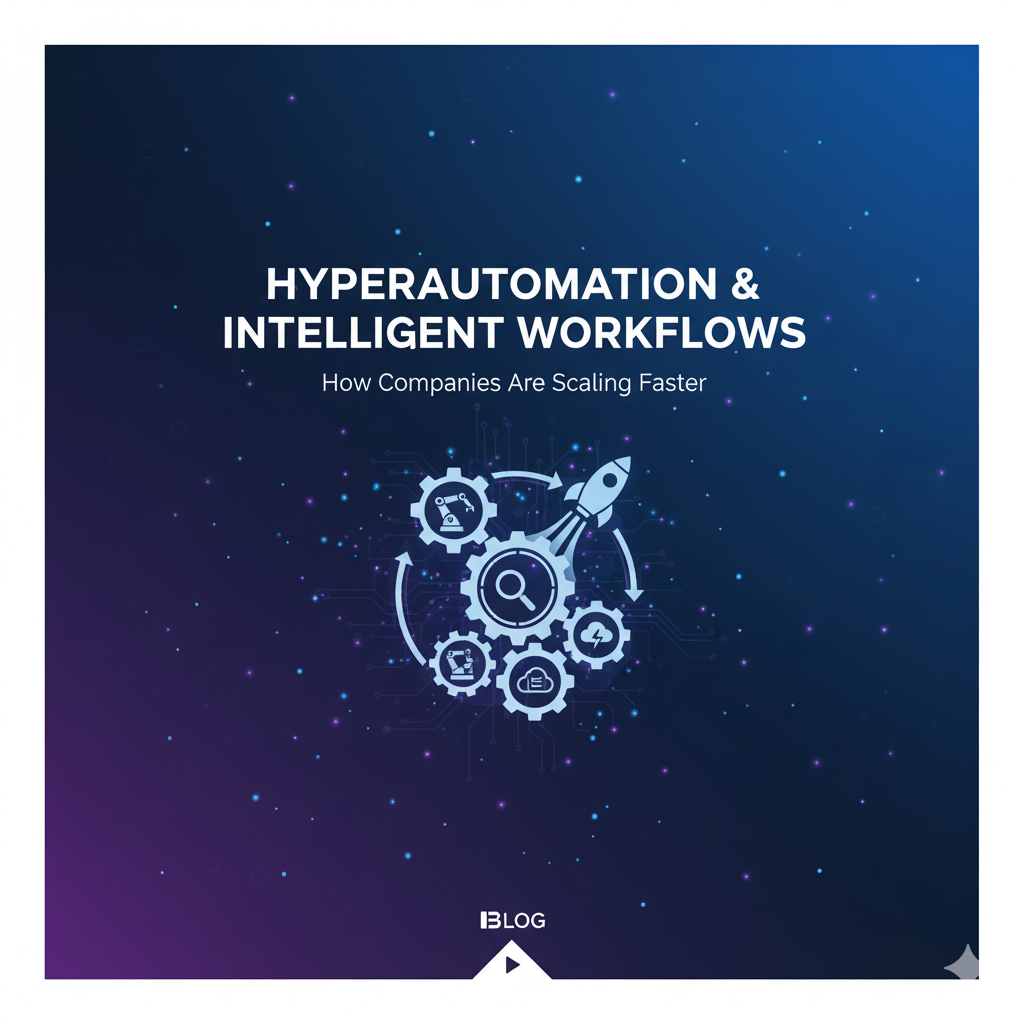
Hyperautomation & Intelligent Workflows: How Companies Are Scaling Faster
In an age when speed, accuracy, and agility decide winners in business, many companies are going beyond piecemeal automation — they’re embracing hyperautomation, where workflows evolve into intelligent, self-optimizing systems. Rather than automating isolated tasks, hyperautomation enables organizations to scale entire processes by integrating AI, RPA, process mining, orchestration, and continuous learning.
For professionals, understanding hyperautomation isn’t just a skill upgrade — it’s a career accelerator.
🔍 What Is Hyperautomation & Intelligent Workflows?Hyperautomation combines multiple technologies — RPA (Robotic Process Automation), AI/ML, NLP, process mining, low-code or no-code, and orchestration tools — to automate not just tasks but whole end-to-end workflows. Instead of a bot doing only data entry, the system can extract information, make decisions, route exceptions, and continually optimize.
Blue Prism frames hyperautomation as the next level above intelligent automation: combining RPA, AI, and integration to transform business operations. (Blue Prism: What Is Hyperautomation?)
🌐 Use Cases: How Organizations Are Scaling Faster-
Invoice & Financial Processing: Using IDP (Intelligent Document Processing) plus orchestration, systems extract invoice data, validate it, route it, and initiate payments—reducing manual oversight.
-
Customer Service & Support Workflows: Bots and AI handle first-level queries, trigger follow-up workflows, escalate only when human input is needed. Camunda outlines many top use cases. (Camunda: Top 10 Hyperautomation Use Cases)
-
IT & Incident Remediation: Systems detect faults, run diagnostics, escalate or resolve issues automatically. PagerDuty’s overview of hyperautomation in IT operations illustrates this. (PagerDuty: Hyperautomation)
-
Regulatory & Compliance Workflows: Automation ensures that audit trails, checkpoints, and policy enforcement are baked into workflows—essential for highly regulated industries.
-
Security & Threat Response: Hyperautomation is being used for IAM tasks, email security, threat hunting, and cloud posture management. Torq’s security hyperautomation examples show the scope. (Torq: Security Hyperautomation Use Cases)
-
Healthcare & Supply Chain: Systems automate medical record workflows, inventory forecasting, order placements, etc. ConnectWise discusses trends like predictive maintenance and AI in manufacturing. (ConnectWise: Hyperautomation Trends 2025)
These examples show how organizations cut cycle times, reduce errors, and gain scalability across functions.
💡 Benefits & Challenges Benefits-
Operational Efficiency & Cost Reduction: Organizations often report dramatic reductions in labor hours and operational costs. SentinelOne notes how hyperautomation helps businesses streamline operations and cut costs. (SentinelOne: What Is Hyperautomation?)
-
Scalability & Flexibility: Workflows scale without proportional increase in headcount.
-
Improved Compliance & Governance: Automated trails, built-in checks, and consistent enforcement.
-
Innovation Time: With routine tasks automated, teams can focus on strategy and value creation.
-
Faster Decisioning: Embedded AI makes decisions in real time, enhancing responsiveness.
-
Legacy System Integration: Many enterprises run older systems not designed for modern integration.
-
Data Quality & Silos: AI models and automation logic require consistent, structured data.
-
Change Management & Talent Gap: Employees may resist automation; new skills are needed.
-
Security & Risk: More automation means more moving parts; oversight is critical.
-
Governance: Ensuring ethical, auditable decision logic across automated workflows is complex.
Here are key platforms & tools commonly used in hyperautomation stacks:
-
UiPath — for RPA, process mining, and integrated orchestration.
-
Blue Prism — with strong support for automation + AI combos.
-
Microsoft Power Platform (Power Automate, Power Apps) — ideal for low-code + automation.
-
Celonis, ABBYY, Appian — process mining and automation orchestration tools.
-
Hyperscience, ABBYY IDP — for document intelligence and unstructured data processing.
-
Custom AI / ML models embedded via frameworks like TensorFlow, PyTorch, etc.
According to Leapwork’s guide on hyperautomation, organizations need to be thoughtful in choosing interoperable tools and constructing scalable architectures. (Leapwork: Hyperautomation — Complete Guide)
🎯 Career Paths & Roles in HyperautomationThe rise of hyperautomation is creating new roles and reshaping existing ones:
-
Hyperautomation Engineer / Architect: Builds and maintains end-to-end automation pipelines.
-
RPA Developer / Workflow Orchestrator: Designs bots and integrates them across systems.
-
Process Mining / Task Mining Analyst: Maps real workflows, identifies optimization paths.
-
AI Model Engineer for Workflows: Creates decision logic, anomaly detection, predictive rules.
-
Governance & Compliance Lead: Oversees policy, audit, and ethical decisioning in automation.
-
Change & Transformation Manager: Manages adoption, stakeholder alignment, training for automated ecosystems.
Reports suggest that many repetitive roles may shrink, but the demand for skilled professionals in automation, AI, security, and analytics will rise significantly. (ConnectWise: Top Benefits of Hyperautomation)
🛤 How to Begin Your Hyperautomation Journey-
Process Discovery / Mining: Use tools like UiPath Process Mining or Celonis to discover automation candidates.
-
Define Business Goals & Metrics: Decide whether you want speed, cost saving, error reduction, etc.
-
Prototype / Pilot Projects: Start with high-impact but manageable workflows.
-
Select Integrated Tool Stack: Combine RPA, AI, orchestration tools that work together.
-
Train & Upskill Teams: Empower citizen developers and automation engineers.
-
Governance & Monitoring: Ensure audit logs, escalation rules, fallback mechanisms.
-
Iterate, Monitor, Scale: Use analytics to refine bots; expand gradually to more processes.
Tags :
- Hyperautomation
- Intelligent Workflows
- Automation Tools 2025
- Business Process Automation
- AI in Operations
- Workflow Optimization
- RPA Trends
- Digital Transformation
- How Hyperautomation is reshaping business processes in 2025
- Career opportunities in intelligent automation
- Tools for building intelligent workflows
- Hyperautomation and AI-driven process improvement
- Benefits of workflow automation in enterprises
- Future of RPA and Hyperautomation in business
- Intelligent automation in manufacturing and IT
- How to implement Hyperautomation in your organization






